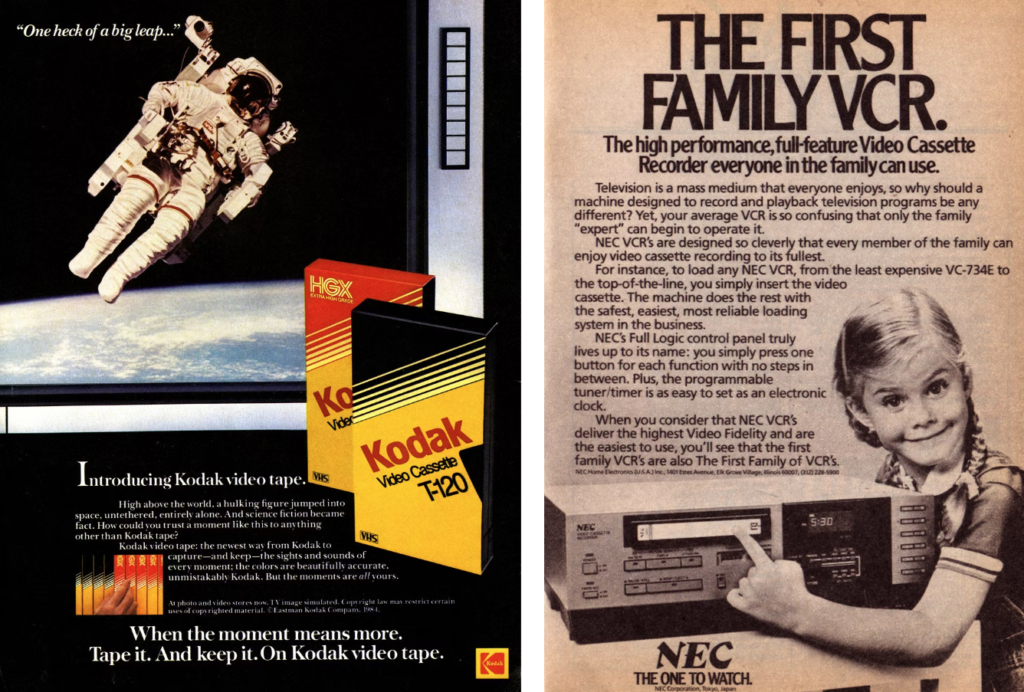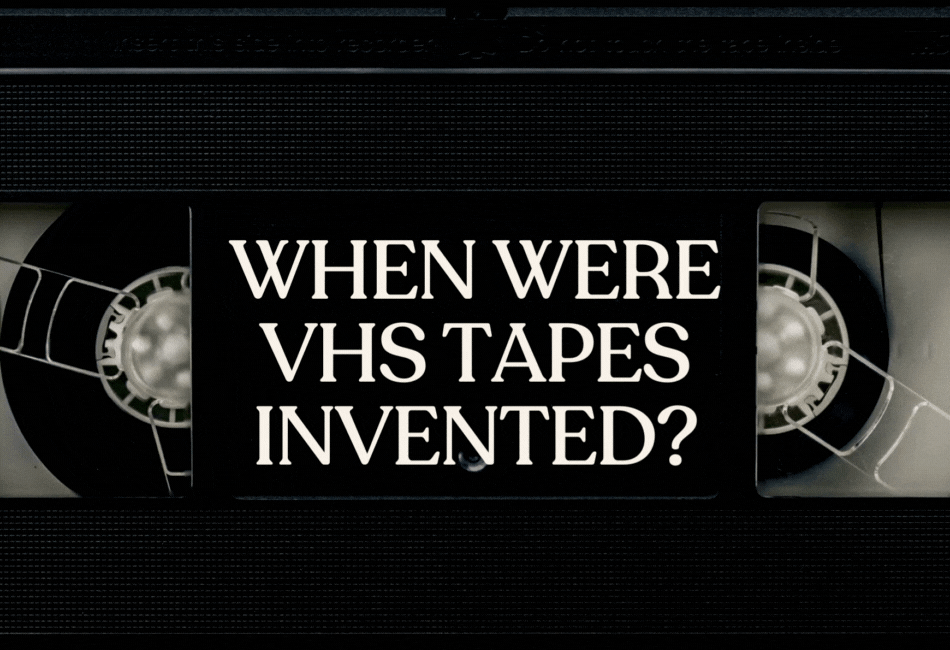In the realm of media storage and playback, VHS tapes have left a huge mark on the landscape of entertainment. Almost as soon as they were introduced, VHS tapes revolutionized the way we consumed movies, TV shows, and other forms of visual content.
In this blog, we’ll delve into the origins of VHS tapes, tracing their development and evolution, understanding how they function, and answering the question of when exactly they were invented.
What are VHS tapes?

Before we explore when VHS tapes were invented, let’s just make sure we’re all on the same page. Although they have since been outclassed, first by DVDs, then Blu-rays, and finally, fully digital formats, VHS tapes were the dominant force in video playback technology for a number of years.
At its core, a VHS (short for Video Home System) tape consists of a thin plastic casing housing a length of magnetic tape. This tape is coated with iron oxide particles, which can be magnetized to record audio and video signals. The VHS player utilizes a helical scan mechanism to read and write data on the tape.
When a VHS tape is inserted into a player, it passes over a spinning drum containing multiple heads. These heads record and read data by magnetizing and detecting changes in the magnetic particles on the tape. The helical scan method allows for efficient use of space on the tape, enabling longer recording times compared to linear recording methods.
During playback, the VHS player retrieves the recorded signals from the tape, converting them into audio and video output for display on a television or monitor. Despite being a relatively simple technology by modern standards, VHS tapes played a pivotal role in democratizing home entertainment and preserving cultural artifacts.
A brief history of VHS tapes
Now we’ve talked about exactly what VHS tapes are and how they work, let’s explore their development. But before we get onto the tapes themselves, we first have to talk about the video cassette recorder — more commonly known as the VCR.
As it happens, the VCR actually pre-dates the development of VHS tapes by over 20 years. The first VCR was produced back in 1956 by Charles Ginsburg and Ray Dolby for the Ampex Corporation. This development was revolutionary for the video playback and entertainment industry.
The major reason that the VCR was such a game-changer was that it allowed for both playback and recording. In practice, this meant that for the first time, television shows could be recorded and then broadcast at a later date. Up until the introduction of the VCR, all television shows had to be broadcast live.
However, the first VCR models were large, unwieldy, and expensive, making them unsuitable and unattainable for home users. The first attempt to produce a consumer-friendly VCR came from a UK-based company, the Nottingham Electric Valve Company.
In 1963, Michael Turner and Norman Rutherford developed what was known as the “television in a can” — or Telcan. The Telcan used a reel-to-reel system that could record approximately 20 minutes of low-quality, black-and-white footage. Although this was an attempt at a consumer unit, it was still prohibitively expensive, and the lack of color recording meant that it was already becoming obsolete even as it was introduced.
Consumers would have to wait until the 70s before the first affordable, home VCR was introduced and the battle between Sony and JVC changed the video landscape forever.

The rise of VHS tapes
The development of VHS tapes dates back to the early 1970s, during the era of intense competition between various home video recording formats. Japanese electronics company JVC is credited with introducing the VHS format in 1976 in response to Sony’s Betamax format, which debuted a year earlier.
What set VHS apart was its longer recording time. Initially, Betamax had an edge in terms of video quality, but VHS’s extended recording capability of two hours on a standard T-120 tape appealed to consumers. This advantage, coupled with strategic marketing and licensing agreements, propelled VHS to dominance in the home video market.
Throughout the late 1970s and 1980s, VHS steadily gained popularity worldwide, becoming the preferred format for recording and distributing movies, TV shows, and personal videos. The introduction of VHS rental stores, such as Blockbuster, further solidified its position, allowing viewers to access a vast library of titles without needing to purchase expensive tapes.
The decline of VHS
The number one reason for the decline of the VHS format was simple technological advancement. The emergence of digital formats, such as DVDs and later streaming services, offered superior picture and sound quality, as well as greater convenience compared to VHS tapes. DVDs also boasted features like menu navigation, chapter selection, and bonus content, enhancing the viewing experience.
Moreover, VHS tapes were bulky and prone to wear and tear with repeated playback, unlike digital media, which offered greater durability and longevity. The shift towards smaller, more compact formats also contributed to the decline of VHS tapes, with devices like DVD players and later Blu-ray players offering sleeker designs and improved functionality.
The rise of streaming services finally made VHS tapes almost completely obsolete. The convenience of instant access to a vast library of content without the need for physical storage space or playback devices accelerated the obsolescence of VHS technology.
These days, VHS tapes are rarely found outside of private collections and in some educational or preservation settings. The technology was outclassed by what came after and faded into obscurity over the years.

Preserve your VHS tapes with EverPresent
Hopefully, this blog has given you a better understanding of what VHS tapes are, when they were invented, and what led to their decline. Although they are now seen as outdated, many people still have VHS collections from years gone by. These collections might just contain your favorite old movies but many also hold cherished family memories.
Just because the format is outdated, it doesn’t mean your memories have to be. Our digitization experts digitize tens of thousands of video tapes each and every year, helping to preserve your memories and keep them safe long into the future.
Reach out to us today and find out how we can help keep your memories safe!

